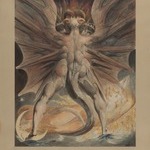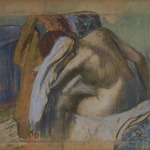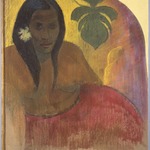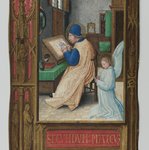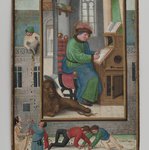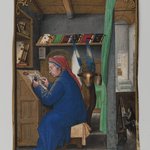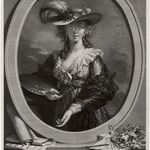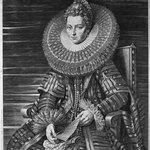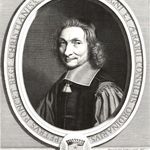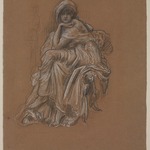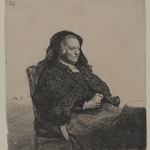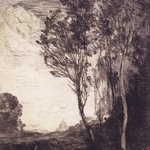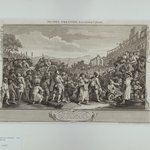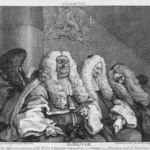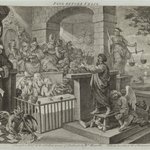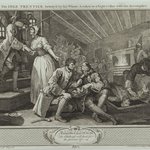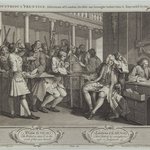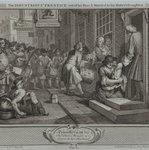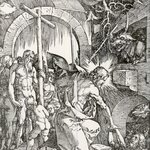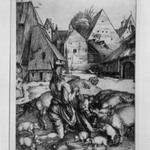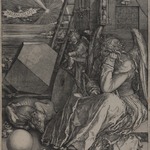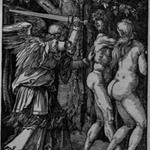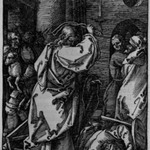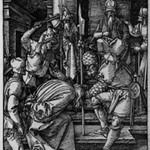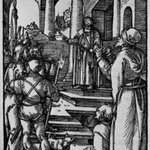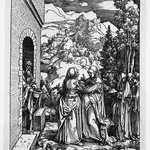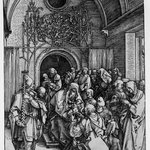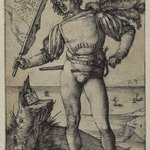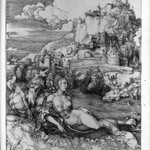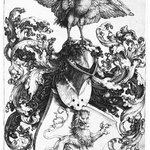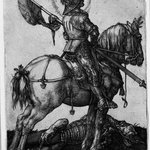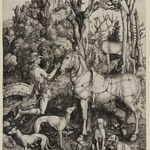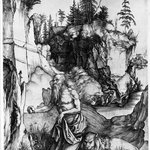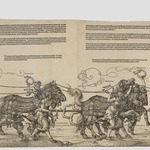
St. Jerome in His Study
Albrecht Dürer
European Art
Saint Jerome in His Study is one of Albrecht Dürer’s three so-called master engravings, along with Knight, Death, and the Devil and Melencolia I, on view nearby. Each image emerges from the paper with extraordinary clarity, with different textures and minute gradations of light and shadow conjured from a careful, dense arrangement of inked marks and lines. Dürer’s contemporary, the scholar Erasmus of Rotterdam, praised the artist’s graphic brilliance, stating that he “could express absolutely anything in monochrome, that is with black lines only—shadows, light, reflections, emerging and receding forms.”
Like the Evangelists in Simon Bening’s nearby illuminations, Saint Jerome here appears at work in a cozy study rendered in careful perspective. The crucifix is a symbol of his faith, and the bishop’s hat and the hourglass hung from pegs allude to worldly life. Jerome’s tame lion dozes side by side with his dog. The skull on the sill is a symbol of mortality, while the large gourd suspended from the ceiling references the promise of resurrection. Rays of light passing through the bull’s-eye windows cast delicate shadows on the wall and floor, creating an atmosphere of harmony and light that evokes the contemplative life of the scholar.
Titus Kaphar: This one is much more spatial. . . .You can enter it. There’s rest. There are these elements in the space, but they’re more a part of the space. They’re part of the narrative, directly. This feels like there may very well have been a model sitting there in the studio. This is an actual space, and [Dürer] sat down and drew him. Then added these other sort of fanciful elements, but that feels like a real space. You get down to the knots, the specificity of the knots and the grains of the wood here, or the particular way that the light is passing through those . . multiple pane windows. It’s very specific.
[Saint Jerome] . . . was credited with translating the Bible. . . . When I did the Jerome Project paintings, and I started that, one of the questions I asked my father was, Where did his name come from? He told me that his father, who was a minister, and his mother, who was very deep in the church, gave him that name in honor of Saint Jerome as a sort of symbol of their value for the Bible, for scripture, for the words that they see as their bread of life. It’s really interesting to see Jerome here in this space, this imaginary, or not imaginary but very specific, space. And I imagine the relationship that my grandparents saw between this particular figure and this young man, who would become their son.
Like the Evangelists in Simon Bening’s nearby illuminations, Saint Jerome here appears at work in a cozy study rendered in careful perspective. The crucifix is a symbol of his faith, and the bishop’s hat and the hourglass hung from pegs allude to worldly life. Jerome’s tame lion dozes side by side with his dog. The skull on the sill is a symbol of mortality, while the large gourd suspended from the ceiling references the promise of resurrection. Rays of light passing through the bull’s-eye windows cast delicate shadows on the wall and floor, creating an atmosphere of harmony and light that evokes the contemplative life of the scholar.
Titus Kaphar: This one is much more spatial. . . .You can enter it. There’s rest. There are these elements in the space, but they’re more a part of the space. They’re part of the narrative, directly. This feels like there may very well have been a model sitting there in the studio. This is an actual space, and [Dürer] sat down and drew him. Then added these other sort of fanciful elements, but that feels like a real space. You get down to the knots, the specificity of the knots and the grains of the wood here, or the particular way that the light is passing through those . . multiple pane windows. It’s very specific.
[Saint Jerome] . . . was credited with translating the Bible. . . . When I did the Jerome Project paintings, and I started that, one of the questions I asked my father was, Where did his name come from? He told me that his father, who was a minister, and his mother, who was very deep in the church, gave him that name in honor of Saint Jerome as a sort of symbol of their value for the Bible, for scripture, for the words that they see as their bread of life. It’s really interesting to see Jerome here in this space, this imaginary, or not imaginary but very specific, space. And I imagine the relationship that my grandparents saw between this particular figure and this young man, who would become their son.
MEDIUM
Engraving on laid paper
DATES
1515
DIMENSIONS
9 5/8 x 7 1/4 in. (24.4 x 18.4 cm) (show scale)
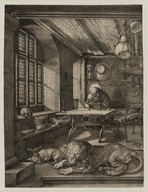


SIGNATURE
Monogram and date in plate.
INSCRIPTIONS
Two indecipherable collectors stamps: a circle in red ink, recto; oval in purplish ink, verso
COLLECTIONS
European Art
ACCESSION NUMBER
57.188.23
CREDIT LINE
Gift of Mrs. Charles Pratt
MUSEUM LOCATION
This item is not on view
CAPTION
Albrecht Dürer (German, 1471–1528). St. Jerome in His Study, 1515. Engraving on laid paper, 9 5/8 x 7 1/4 in. (24.4 x 18.4 cm). Brooklyn Museum, Gift of Mrs. Charles Pratt, 57.188.23 (Photo: Brooklyn Museum Photograph, 57.188.23_PS11.jpg)
IMAGE
overall, 57.188.23_PS11.jpg. Brooklyn Museum Photograph, 2022
"CUR" at the beginning of an image file name means that the image was created by a curatorial staff member. These study images may be digital point-and-shoot photographs, when we don\'t yet have high-quality studio photography, or they may be scans of older negatives, slides, or photographic prints, providing historical documentation of the object.
RIGHTS STATEMENT
No known copyright restrictions
This work may be in the public domain in the United States. Works created by United States and non-United States nationals published prior to 1923 are in the public domain, subject to the terms of any applicable treaty or agreement.
You may download and use Brooklyn Museum images of this work. Please include caption information from this page and credit the Brooklyn Museum. If you need a high resolution file, please fill out our online application form (charges apply).
The Museum does not warrant that the use of this work will not infringe on the rights of third parties, such as artists or artists' heirs holding the rights to the work. It is your responsibility to determine and satisfy copyright or other use restrictions before copying, transmitting, or making other use of protected items beyond that allowed by "fair use," as such term is understood under the United States Copyright Act.
The Brooklyn Museum makes no representations or warranties with respect to the application or terms of any international agreement governing copyright protection in the United States for works created by foreign nationals.
For further information about copyright, we recommend resources at the United States Library of Congress, Cornell University, Copyright and Cultural Institutions: Guidelines for U.S. Libraries, Archives, and Museums, and Copyright Watch.
For more information about the Museum's rights project, including how rights types are assigned, please see our blog posts on copyright.
If you have any information regarding this work and rights to it, please contact copyright@brooklynmuseum.org.
RECORD COMPLETENESS
Not every record you will find here is complete. More information is available for some works than for others, and some entries have been updated more recently. Records are frequently reviewed and revised, and we welcome any additional information you might have.
